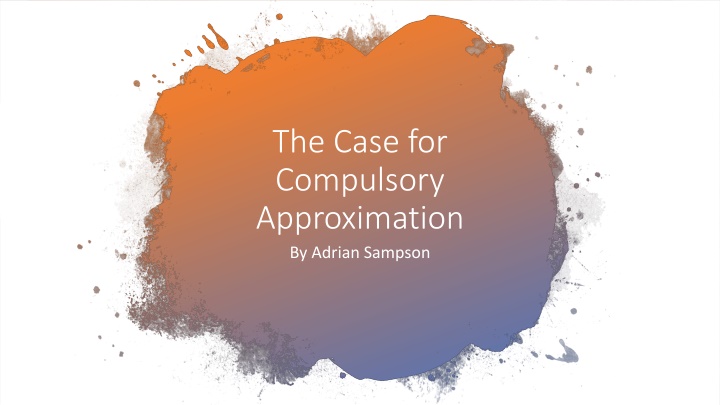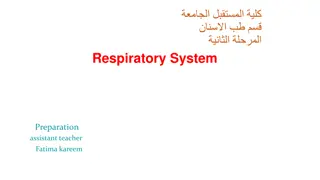
Exploring Compulsory Approximation in Technology Domains
Delve into the concept of compulsory approximation in various technology domains highlighted by Adrian Sampson. Discover the benefits, challenges, and application of compulsory approximation techniques in machine learning and parallel computing methods like Hogwild. Uncover how existing approximations can be leveraged to enhance computing efficiency and quality.
Uploaded on | 3 Views
Download Presentation

Please find below an Image/Link to download the presentation.
The content on the website is provided AS IS for your information and personal use only. It may not be sold, licensed, or shared on other websites without obtaining consent from the author. If you encounter any issues during the download, it is possible that the publisher has removed the file from their server.
You are allowed to download the files provided on this website for personal or commercial use, subject to the condition that they are used lawfully. All files are the property of their respective owners.
The content on the website is provided AS IS for your information and personal use only. It may not be sold, licensed, or shared on other websites without obtaining consent from the author.
E N D
Presentation Transcript
The Case for Compulsory Approximation By Adrian Sampson
Introduction What is Compulsory Approximation ? - Definition of Compulsory: required and obligatory - Meaning: Approximation that is already applied into a specific domain. What have we seen so far ? We have talked about many approximate strategies and approximate computing on specific domain to increase quality and save energy. This time we go back to review Compulsory Approximations
Main goal of this Paper This essay surveys domains with compulsory approximation; and advocates for research that builds new concept for old approximations. Basically Bring techniques from domains with compulsory approximation into the approximate-computing fold. Instead of developing new approximation strategies from whole cloth and then working to apply them, the community should go to where approximations are already widespread.
Benefits 1-Stand to benefits from new abstractions(concept) for approximation they already use 2-Have long been used and already dealt with problem approximate computing have seen The paper list example of domains with compulsory approximation and list way the community can engage with them
Compulsory Approximation: Machine learning Machine learning tools and technology that you can utilize to answer question (prediction) about with your data(training) While machine learning and AI are progressing still difficult to trust. According to the author for example: deep-learning implementers use a technique called dropout, which randomly deletes neurons from networks during training . Dropout appears to avoid overfitting, leading to a better training result but it is hard to see exactly why it works or explain when it might go wrong
Hogwild Similarly, Hogwild! is a technique for parallel stochastic gradient descent (SDG) that ignores data inconsistency. In HOGWILD!, processors are allowed equal access to shared memory and are able to update individual components of memory at will. Only, when the data access is sparse, meaning that individual SGD steps only modify a small part of the decision variable.
Assume a shared memory model with processors. The decision variable x is accessible to all processors. Each processor can read x and can contribute an update vector . The vector x is stored in shared memory, and we assume that the component wise addition operation is atomic, that is xv = xv + a
We can offer We can offer: Tools for expressing and enforcing quality requirements in the language, especially when composing learning components into larger systems.
Compulsory Approximation: Numerical and Scientific computing Floating point highly used have two advantage: -Speed and efficiency - Easier for computer to deal with - It can deal with big numbers and small numbers without needing an enormous amount of space - The floating-point error problem has spawned an entire field of study, such as numerical analysis
We can offer We can offer: Tools to automate tedious accuracy analyses and transformations that currently require experts.
Compulsory Approximation in Real time Graphic Real-time computer graphics or real-time rendering is the sub-field of computer graphics focused on producing and analyzing images in real time Often used in reference to interactive 3D computer graphics, typically using a GPU. One example of this concept is a video game Game engines will go to extremes to maintain a smooth frame rate by simplifying scenes wherever possible. Level-of-detail (LOD) techniques simplify objects for quick-and-dirty rendering when they are rendered in the background of a complex scene .
The cost of 60 frames per second https://www.youtube.com/watch?v=- gQMulb6T2o&feature=youtu.be&ab_channel=DigitalFoundry
Compulsory Approximation in Communication Communication is fundamental for transmitting data from one model and an other. We have seen many types of communication such as network, hardware or software. However error can occur. For instance in wireless communication channels are noisy, so protocols and circuits for communication are forced to contend with random errors.
We can offer We can offer: New circuit-level approximation strategies that match the error models that communications hardware can already tolerate. Approximate communication technique for reducing memory bottlenecks Approximate communication framework for network chip
Questions 1 What is Compulsory approximation a) Approximation that is already applied into a specific domain. b) Approximation that focus on Neural acceleration c) Approximation that focus on Wireless communication
Question 2 What is the benefit of studying Compulsory Approximation ? a) Have long been used and already dealt with problem approximate computing have seen b) Learn the basic of approximate computing c)None of the above
Question 3 What is a deterministic system ? a) A system in which no randomness is involved in the development of future states of the system b) A system where the model produce the different output from a given starting condition or initial state. c) A system which allow potential error for a model to have








